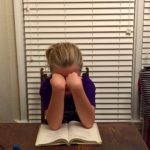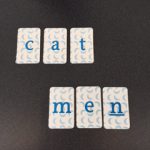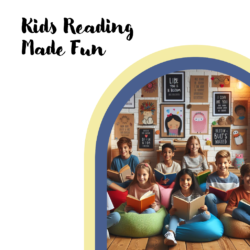How My First Grade Teacher Made Reading With Phonics More Exciting
When I was in the first grade, my teacher taught our class how to read using the phonetic approach. Reading quickly became my favorite subject! It seemed fun and easy! I mastered the art of breaking words apart, sounding them out, and putting them back together until I no longer needed to do this.

I was becoming a “miniature master” of reading! And believe me, I read everything I could, including the cereal box! I think I drove my parents crazy as I would yell out the names of street signs, names of stores, and even items on the menu whenever we would go out to eat! (Actually, I think I was just making sure that they, and everyone else around, could see that “I knew my stuff!”)
I was very blessed to have a wonderful 1st grade teacher who taught reading in a fun way! And…in this post, I am going to show you how your child can learn to read phonetically in a more exciting way, as well!
A First Year Teacher’s Nightmare
When I was a first year teacher, I was so excited! I was hired to teach first grade, and I was finally going to be able to put to use all that I had learned in college! At least, that’s what I thought.
That was, until my school district announced during the third week of school that we were to put all of our phonics materials in storage, and teach reading using a completely different method that I had never even heard of. I panicked. I mean, I literally panicked!
How was I supposed to learn a completely different strategy of teaching kids how to read in one week? I was ready to pull my hair out as I stayed up late every night, trying to get a handle on this new reading strategy. This was definitely a nightmare.
By the end of the year, a little less than one-half of my class knew how to read. I felt like I had failed my students, and I was honestly ready to give up. Thankfully, I didn’t!
The next year, my school district graciously allowed us to incorporate phonics into our teaching methods, and what a huge difference that made! By the end of that year, almost all of my kiddos were reading on grade level, and they really seemed to enjoy it! I felt like I was on top of the world watching them spend time sharing their favorite books with each other!

The New Teaching Trends
Since you’re reading this, I am assuming that you have a struggling reader that you are needing help with. Trust me, you are not alone. I meet parents of children who are having difficulty reading on a daily basis, and they are just as frustrated as their children.

These days, it seems that more and more school districts are moving away from teaching the phonetic way in favor of more “inventive” ways of teaching kids to read. Please, don’t get me wrong. I completely understand that not all children learn the same way.
In my business, I teach reading using many different methods, depending on the learning style of each child. However, I am a firm believer in teaching kids to read using a sound phonics base, as well.
As the owner of a private tutoring business, I am seeing more and more children come to me every year who are frustrated and ready to give up because they can’t read on their grade level. In fact, some of the kids who come to me are reading several years below their grade level.

This breaks my heart because many of them tell me that they hate to read. In reality, a great majority of these kids are actually smart! They have just never been taught to read in a way that they understood, nor retained.
What Exactly is Phonics?
In my first post, I stated that reading begins with the abc’s. And, it does. Children need to know the letters of the alphabet, and the sound that each letter makes. Then, they will be more able to put these letters together to make words. This is how reading begins!

Phonics is just a way of teaching children to read by learning the sounds of letters, groups of letters, and syllables, and putting them together to make words. It also includes breaking longer words apart, sounding them out, and putting them back together. It may sound confusing, but in reality, this is what gives kids a sound basis for reading!
Making Phonics Fun at Home
I would love to give you some ideas of things that you can do at home to give your child a firm grasp of basic reading! Please keep in mind that most of these are geared towards Kindergarten and first graders who are just beginning to read. However, I have used these same strategies with some of my older children who were struggling readers, and they actually worked! If you see something you might be interested in, please click on the words highlighted in dark blue, and they will take you to different sites where you can check them out!
1. For starters, you can use what I like to call “letter tiles“ to help your child read basic three letter words. (In the phonics page within my site, I explain exactly how I use these tiles to have my kids read words.)
to help your child read basic three letter words. (In the phonics page within my site, I explain exactly how I use these tiles to have my kids read words.)
Basically, I start with three letters such as c, a, t. Then, I spread them apart, and have the child sound each letter out. Then, we blend the letters together to make the word. The kids love this, partially due to the fact that they finally feel that they are actually reading! They especially like it when they get to make their own words using their letter tiles! I have included a short video by Jo Bolin that shows a lesson in which letter tiles are used to make words. Hope you enjoy!
2. Another great way to make the reading process more interesting is to make a “word wall.” As your child begins to put basic words together, write each word on a large index card. Then, either cut out a picture from a magazine of what the word is, or copy one from the internet and glue it to the index card. You can then tape these up to your child’s bedroom wall!
When I taught 1st grade, I had one entire wall of my classroom devoted to words/pictures that the children had created! They would often use many of these words in their journals. So, it not only served as a reading tool, but also helped them with their spelling, as well! This was an added bonus for sure!

3. “Magnetic Letters“ are another great way to teach kids to put letters together to make words. You can buy colorful magnetic letters with matching boards from many wholesale stores. When my niece was in Kindergarten, my brother and sister-in-law used magnetic letters on their refrigerator so that she could practice making simple words. She loved it!
4. Yet, another creative way to engage your child in the process of reading and writing is to write him/her a short 2 or 3 sentence “letter” using several of the words they have learned to read. Then, put a stamp on it and mail it to your address!
Kids love getting their own mail! I did this with my niece, and she actually wrote me back using a few of her words from her word wall! She thought she was “hot stuff” getting her own mail!

5. There are also some fun bathtub activities that you can do with your child during bath time to make the “bath” experience so much more enjoyable! Try buying “bathtub letters!” These are spongy letters of the alphabet that stick to the sides of the bathtub, and even to most tile walls. Make 3 letter words by sticking them to the wall or side of the bathtub that your child has been learning how to read, and have him/her sound them out! Pretty soon, they will know the words by memory!
You can also buy bathtub crayons. Your child can practice writing the words that they are learning to read on the side of the bathtub! Then, you can just wipe the words off with a washcloth. Kids love this, and they get clean in the process! What more can you ask for?
These are just some ways to get your child started out on the right track when they are first learning how to read. I hope you have a great time working with your child! Please keep checking back as I will be updating my site on a regular basis.
Affiliate Disclosure
I would like to be open and transparent with you, as parents and caregivers. When you buy something from the websites listed on my site, I may receive an affiliate commission. I never recommend poor quality products, or create false reviews to make sales. The opinions I express are not representative of the companies that create these products. It is my intention to explain products in such a way that you can make informed decisions on which ones best suit your needs.
I would love to hear from you! Please leave a comment or question below, and I will get back with you as soon as possible. And as always…Happy reading to you and your child!
Blessings:)
Suzi

Great ideas! I will have to try them with my kids.
Hi Bridget! Please do try some of these, and let me know how they worked:) The examples I listed are only a few, and there are many more to come! Thanks so much for leaving a comment!
Blessings:)
Suzi
Suzi,
When Chris was learning to read, we used the talking magnetic frog letters and a wipe off board. He did not have a teacher that used phonics in school. He still uses the wipe off board for different things. He has developed a need to read books any time we are traveling or he cannot go out with his friends. Early reading and understanding words are critical to a good education.
John
Thanks so much for sharing, John:) I totally agree with you! Early reading is very critical to a good educational foundation. I wish that everyone thought this way! There are so many components to reading, with phonics being only one. However, I believe that with phonics, a majority of kiddos tend to get lost along the way. I hope that Chris is doing well with his reading, and is enjoying it!
Blessings:)
Suzi
Hi Suzi
Phonics are brilliant. Once a child gets the idea, they can read any word. You should listen to me spelling for my daughter, Lol! It’s really inspiring to see little ones mastering reading just by leaning their phonics.
Thank you for the work that you do Suzi. I am a mom who has come to know the unsurpassed value of phonics.
🙂
~Danielle
Thank you so much, Danielle, for your beautiful comment! I’m so glad that you believe in phonetic learning:) This will definitely give your daughter success with her reading, writing, and spelling! I wish you all the best with your little girl! They really are cute when they are just learning to read! Children are definitely one of God’s greatest gifts to the world!
BLessings:)
Suzi
So I have commented on different pages of yours in the past and love your articles. I remember referencing how important it was to make as much teaching into “games” for the kids as possible.
Does this sort of work the same way. I almost feel as if kids are afraid of the whole “reading” concept and that makes them not want to learn.
But does it work out a lot better when they get to use their own creativity in making words. When playing with things like the magnetic tiles they feel like they are playing on their own terms and making whatever they want. In reality they are actually rearranging new words and learning how to sound them out.
This eventually allows them to pair words together and begin to learn to read. Is that the foundation you are talking about or am I little bit off? Thanks
Hi again, Brad! Thank you for commenting on so many of my posts! That means a lot:) I think you’re right about some kids being afraid of the whole “reading concept.” This is what I usually see for my struggling readers. Teaching reading through phonics and the use of “reading games” work well for most of them. My kiddos who are already reading well no longer need any added incentives to encourage them to want to read. They do it because they want to! This is my goal for children around the world. I want them to see that reading can take them places they’ve never been to before! This is my mission! Again, thank you for your questions and comments. They were very insightful!
Blessings:)
Suzi
Great blog on Reading Suzi.
As soon as I saw the word “phonics”, I was in. A long time ago, we taught our children to read with phonics.
My mother taught me how to read and this is without any doubt, the most important skill to learn in school, especially at an early age. It sets the bar for all your future learning.
If you can’t read well, you remain uneducated and poverty will be a future possibility for you. Stress this most important of all concepts to all your students.
Paul
Thank you, Paul! Another fan of phonics-yea! It seems that so many school districts have removed this from their curriculum. I still have high school kids coming to me for tutoring who can’t read. This, to me, is a tragedy because they are getting ready to embark on their future careers. However, without the proper reading skills, they will only continue to struggle. I’m so glad that you were informed enough to teach your kids to read with phonics. You not only gave them a firm basis for reading, but hopefully, instilled the love of reading that will carry into their adult years! Thanks so much for sharing:)
Blessings:)
Suzi
Hi again Suzi,
I love these ideas! When I have kids I will use them too. I agree that phonics gives kids a great sense of empowerment because they feel like they can figure words out for themselves. They want to learn new words since it is something they can feel proud of and it is a challenge to find and figure out new words each day. I am so glad my parents made sure I learned to read with phonics. I really don’t understand why it was phased out since I also know people who learned without phonics and they really struggled to read.
I am so glad you are spreading the word on phonics!
Hi Jessica! Thanks so much for your comment on my phonics page:) I totally agree with you about children having a sense of empowerment when they can actually break words apart and put them back together to form words. I’m not sure why many school districts have phased out the teaching of phonics. I actually have a friend who teaches 1st grade, and was told to throw out all of her phonics programs several years ago. However, when the end of the year came and she had only a handful of kids reading, she knew she was in trouble! So, the next year, she craftily brought it back in, along with sight words, and had an amazing year! By the end of that year, almost 100% of her kiddos were reading on grade level. I know that not every child learns the same way. I think we should give them a chance to learn to read using a variety of different reading methods. That way, hopefully all kids will have the ability to learn to read in the way that works the best for them at their own pace. I sincerely hope that you do incorporate phonics with your kids someday! I think it will lead to them having much more successful futures on down the line:)
Blessings:)
Suzi